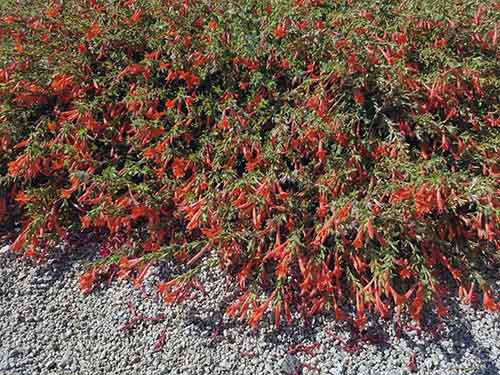We often talk about pollinator gardens in reference to bees and butterflies, but hummingbirds also play an integral role in pollination of many of our native and ornamental plants. Red-colored, tubular-shaped flowers tend to be favorites for hummingbirds. When they dip their long bills into the flowers to feed on the sweet nectar, they get pollen on their faces. This makes them great pollinators for many species of plants that aren’t pollinated by bees or butterflies.
 Many of our hummingbirds migrate for winter, but spend March to September in our region to nest and feed on nectar. Creating a hummingbird garden is easy and can be integrated into your current landscape by the addition of a few nectar sources and a water source. We recommend putting your hummingbird feeding plants close to a window in your home so you can watch as they come to feed. When choosing flowers, pay attention to bloom times to ensure you will have a good supply of food all season. Hummingbirds feed on flowers with the highest sugar content, seeking out protein from insects.
Many of our hummingbirds migrate for winter, but spend March to September in our region to nest and feed on nectar. Creating a hummingbird garden is easy and can be integrated into your current landscape by the addition of a few nectar sources and a water source. We recommend putting your hummingbird feeding plants close to a window in your home so you can watch as they come to feed. When choosing flowers, pay attention to bloom times to ensure you will have a good supply of food all season. Hummingbirds feed on flowers with the highest sugar content, seeking out protein from insects.
The three most common hummingbirds for our area are Anna’s, Black-chinned and Calliope hummingbirds.
Anna’s hummingbirds, with a pinkish red crown and green back, were named after Anna Messena, Duchess of Rivoli. These beautiful specimens are commonly spotted where bird baths and nectar are found. To attract them to your garden, plant red- or fuchsia-flowered gooseberry (Ribes speciosum), red hot poker (Tritoma), California fuchsia (Zauschneria californica), redflower false yucca (Hesperaloe parviflora), manzanita (Arctostaphylos spp.) and desert willow (Chilopsis linearis).
Another common hummingbird in our area is the Black-chinned or Alexander hummingbird. It has a vibrant violet collar with a black head and white chest. It enjoys feeding on the nectar of red colored lupines (Lupinus spp.), scarlet or mountain larkspur (Delphinium spp.), fireweed (Chamerion angustifolium) and foxgloves (Digitalis purpurea).
Lastly, the Calliope hummingbird, the smallest bird in the U.S., has very unique magenta markings on its chin, with a mostly green body. It can be found feeding on wild bergamot (Monarda fistulosa), golden currant (Ribes aureum) and coralbells (Heuchera sanguinea). These small birds tend to feed on smaller flowers than the larger hummingbirds do.
When making your hummingbird garden, select plants native to our region when possible, as many native birds are already adapted to them. Remember to include diverse nectar sources, including a variety of flower sizes and shapes. Columbine and aster are native to our area and provide diversity in flower style to attract hummingbirds.
Also provide hummingbirds with perches and trees for nest-building, for resting and to provide a vantage point so they can scout their territory. Reduce your use of pesticides, as they have shown to harm hummingbirds.
Don’t forget to always provide a water source nearby. A small bird bath or feeder with sugar water is sufficient. You can watch the hummingbirds drink or perch on the edge, even if it’s only for a brief second.
Fisher, J.
2018,
Add plants to attract hummingbirds,
Reno Gazette Journal


